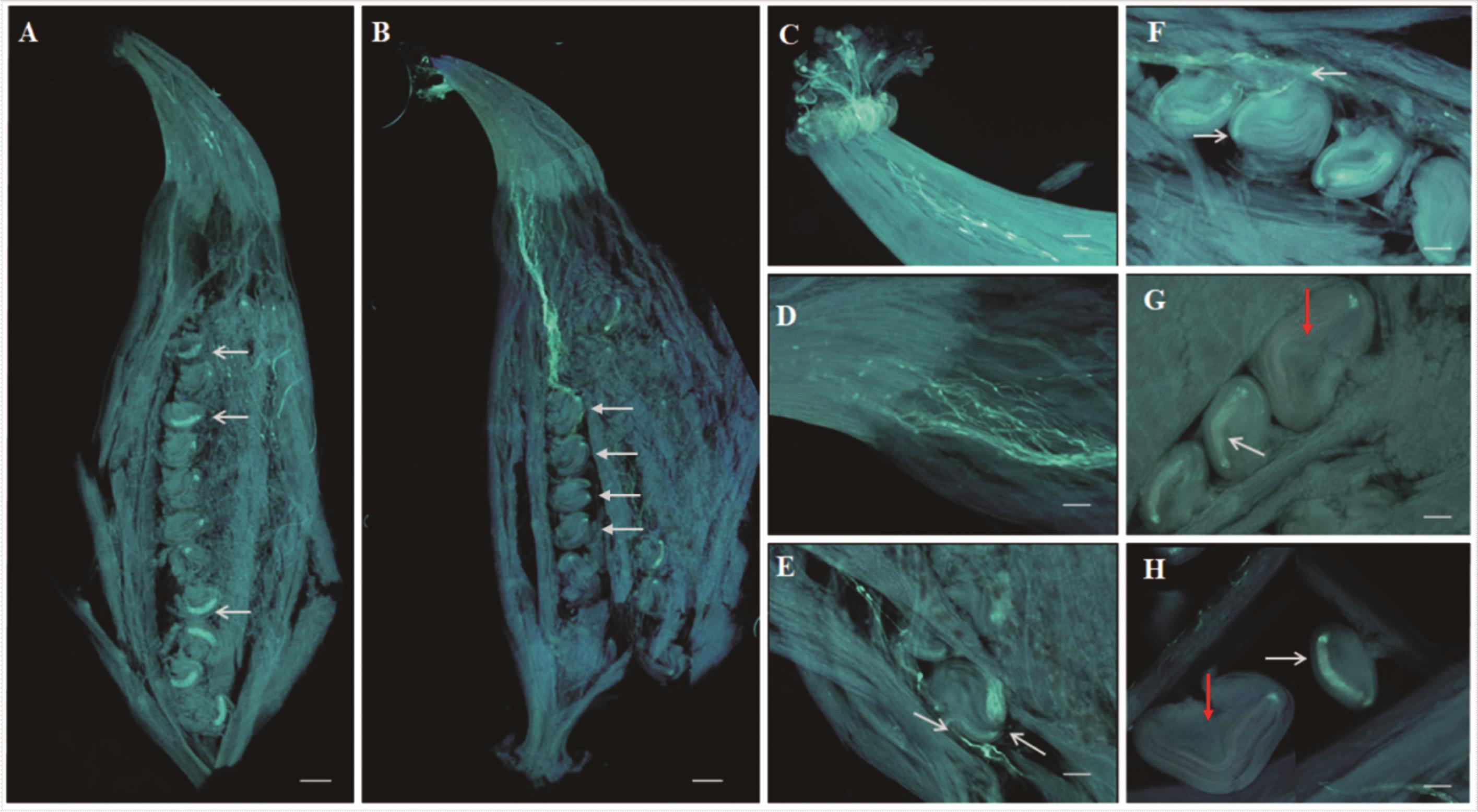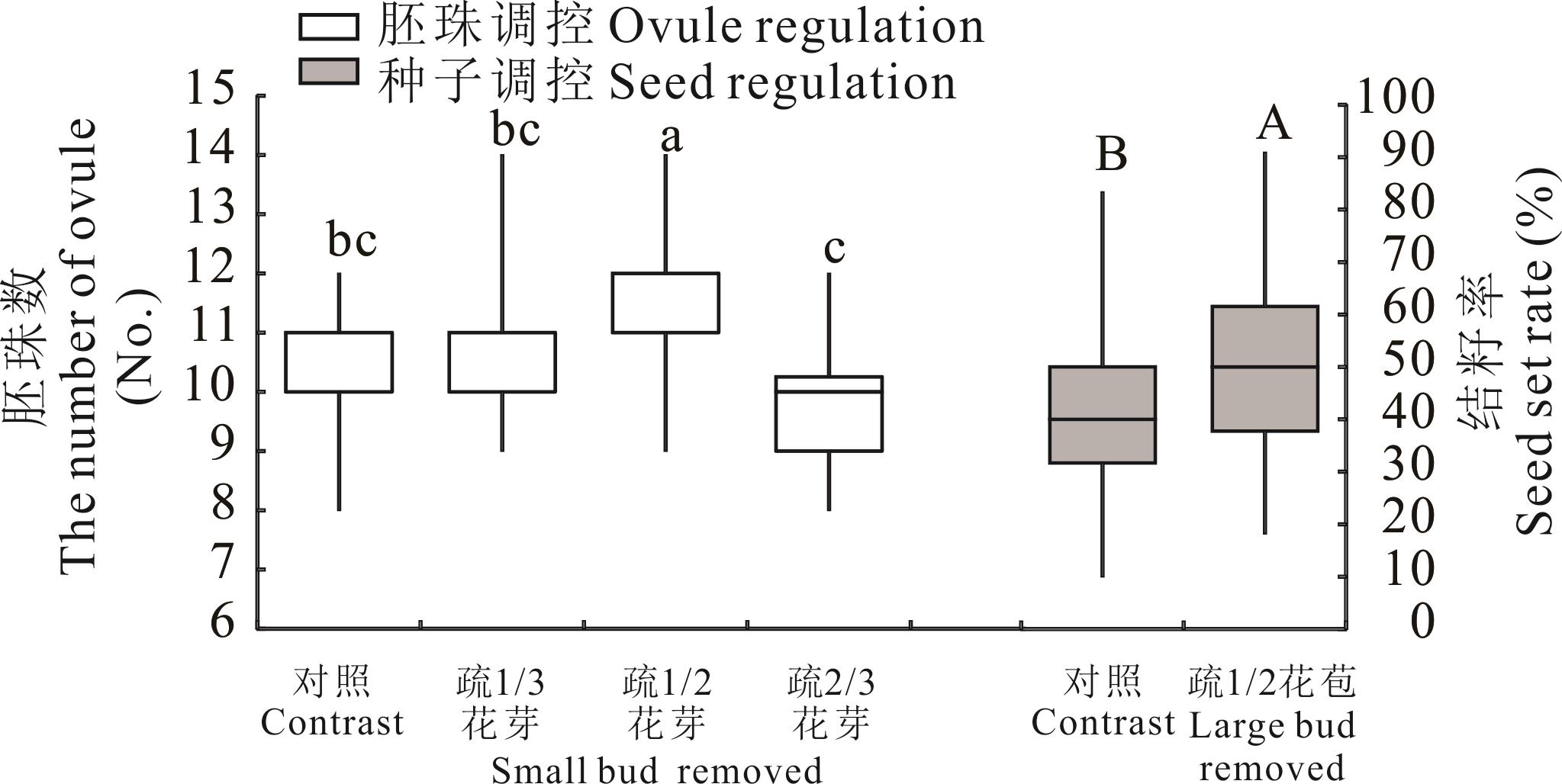

ISSN 1004-5759 CN 62-1105/S


草业学报 ›› 2024, Vol. 33 ›› Issue (12): 111-121.DOI: 10.11686/cyxb2024028
• 研究论文 • 上一篇
约仁萨·阿卜迪力木1( ), 赵伟2, 王晓伟1, 黄岩1, 张爱勤1(
), 赵伟2, 王晓伟1, 黄岩1, 张爱勤1( )
)
收稿日期:2024-01-17
修回日期:2024-03-25
出版日期:2024-12-20
发布日期:2024-10-09
通讯作者:
张爱勤
作者简介:. E-mail: 1131646332@qq.com基金资助:
Abudilimu YUERENSA·1( ), Wei ZHAO2, Xiao-wei WANG1, Yan HUANG1, Ai-qin ZHNAG1(
), Wei ZHAO2, Xiao-wei WANG1, Yan HUANG1, Ai-qin ZHNAG1( )
)
Received:2024-01-17
Revised:2024-03-25
Online:2024-12-20
Published:2024-10-09
Contact:
Ai-qin ZHNAG
摘要:
果实水平上的“胚珠多种子少”现象是种子生产中的一个共性问题,其中,有性繁殖过程至关重要,进行受精前后胚珠发育及种子形成动态的研究,对揭示种子产量的形成机制具有重要意义。以新牧4号紫花苜蓿为研究对象,通过切片、荧光观察及人工控制试验等,对其受精前后胚珠的发育、受精过程及结籽格局等进行研究,探讨有性繁殖方面制约种子产量形成的因素。结果表明:1)受精前,胚珠发育没见异常,腹缝线上也不具有维管分布的位置效应,但在受精过程中,19.6% 的成熟胚囊被胼胝质包裹而不能正常受精。2)异花授粉较自花授粉具有更高的花粉萌发率和花粉管生长速度,进入子房后的花粉管优先达到子房的中部和基部,并使得这些位置的胚珠优先受精。3)自然条件下,授粉后第2天,中部和基部胚珠优先膨大,第3~6天,膨大胚珠的比例进一步增加,随后基部和中上部已经膨大的部分胚珠出现败育,最终形成荚果内两端胚珠败育率高、中间低的结籽格局。4)资源调控试验表明资源限制不仅影响受精前胚珠形成的数目,还加剧受精后已膨大胚珠的败育率。综上所述,新牧4号紫花苜蓿胚珠的发育与种子的形成受胼胝质沉积、受精顺序、资源分配状况及位置效应多种因素的影响,其中,由胼胝质沉积引起的受精率低以及资源限制引起的受精后胚珠的败育率高是影响种子产量的主要因素。
约仁萨·阿卜迪力木, 赵伟, 王晓伟, 黄岩, 张爱勤. 新牧4号紫花苜蓿受精前后胚珠发育及种子形成动态[J]. 草业学报, 2024, 33(12): 111-121.
Abudilimu YUERENSA·, Wei ZHAO, Xiao-wei WANG, Yan HUANG, Ai-qin ZHNAG. Ovule development before and after fertilization and seed formation dynamics of Medicago sativa cv. Xinmu No.4[J]. Acta Prataculturae Sinica, 2024, 33(12): 111-121.

图1 雌配子体的发育及维管分布A: 大孢子母细胞Megaspore mother cell; B: 二核胚囊2-nuclear embryo sac; C: 四核胚囊4-nuclear embryo sac; D: 八核胚囊(EC: 卵细胞; S: 助细胞)8-nuclear embryo sac (EC: Egg cell; S: Synergidae); E: 花芽的横切(成熟花药) Cross section of bud (Mature anther); F, G: 子房中维管束及其分布Vascular distribution in ovary。图中刻度Scale bar: 100 μm (A~D, F); 250 μm (E, G).
Fig.1 The development of female gametophytes and vascular distribution in M. Sativa cv. Xinmu No.4

图2 花粉萌发、花粉管生长及胚珠胼胝质的沉积A, B: 子房内胚珠的胼胝质沉积Callose deposition of ovules at different positions; C,D: 花粉的萌发与花粉管的生长Pollen germination on stigma and pollen tubes growth in style; E, F: 花粉管的“N”形生长与分布The pollen tube distribution and entering micropyle in an “N” shape; G, H: 发育胚珠和不发育胚珠的胼胝质沉积Callose deposition of devoloping ovules and undevoloping ovules。图中刻度Scale bar: 250 μm (A, B); 100 μm (C~H)。
Fig.2 The germination of pollen, growth of pollen tube and callose deposition on ovules in M. Sativa cv. Xinmu No.4

图4 开花后第3~21天新牧4号紫花苜蓿胚珠败育及种子形成动态
Fig.4 The ovule abortion and seed formation at different positions in ovary at 3-21 days after opening in M. sativa cv. Xinmu No.4

图6 新牧4号紫花苜蓿胚珠与种子发育的资源调控不同小写字母表示疏花芽处理与对照差异显著(P<0.05), 不同大写字母表示疏花苞处理与对照差异显著(P<0.05)。Different lowercase letters indicate the significant difference at 0.05 among treatments of removing small buds and contrast; Different capital letters indicate the significant difference at 0.05 between treatments of removing large buds and contrast.
Fig.6 The development of ovule and seed of M. sativa cv. Xinmu No.4
| 1 | Valtueña F J, Olivencia A O, Riaño T R. Regulation of fruit and seed set in Anagyris foetida L. (Fabaceae): The role of intrinsic factors. Giornale Botanico Italiano, 2012, 146(S1): 190-200. |
| 2 | Valtueña F J, Olivencia A O, Riaño T R, et al. Causes of low fruit and seed set in bird-pollinated Anagyris foetida (Leguminosae): Pollen limitation and other extrinsic factors. Folia Geobotanica, 2010, 45(1): 77-94. |
| 3 | Palermo B R Z, Agostini K. Componentes de fecundidade em Erythrina speciosa (Leguminosae, Faboideae). Títulos Não-correntes, 2010, 24(1): 13-19. |
| 4 | Arathi H S. Selective embryo abortion in a perennial tree-legume: A case for maternal advantage of reduced seed number per fruit. Journal of Plant Research, 2011, 124(6): 675-681. |
| 5 | Han J G. Practical grass seed science. Beijing: China Agricultural University Press, 1997: 46-67. |
| 韩建国. 实用牧草种子学. 北京: 中国农业大学出版社, 1997: 46-67. | |
| 6 | Yang L Y. Studies on the female sterility mechanism of fsvl rice based on gene expression analysis of developing ovule. Wuhan: Wuhan University, 2016. |
| 杨丽玉. fsv1水稻胚珠发育过程中基因表达及不育机理研究. 武汉: 武汉大学, 2016. | |
| 7 | Rosellini D, Ferranti F, Barone P, et al. Expression of female sterility in alfalfa (Medicago sativa L.). Sexual Plant Reproduction, 2003, 15(6): 271-279. |
| 8 | Rocha O J, Stephenson A G. Order of fertilization within the ovary in Phaseolus coccineus L.(Leguminosae). Sexual Plant Reproduction, 1991, 4: 126-131. |
| 9 | Wang X W, Han J L, Zhang A Q. Seed selective abortion pattern under the influence of two reciprocal resource gradients in Caragana acanthophylla. Acta Ecologica Sinica, 2022, 42(12): 4872-4881. |
| 王晓伟, 韩佳玲, 张爱勤.两种互逆资源梯度影响下刺叶锦鸡儿的种子选择性败育格局. 生态学报, 2022, 42(12): 4872-4881. | |
| 10 | Han J L. The selective abortion of seeds and its influencing factors in two legume plants. Urumqi: Xinjiang University, 2020. |
| 韩佳玲. 两种豆科植物种子的选择性败育及其影响因素. 乌鲁木齐: 新疆大学, 2020. | |
| 11 | Yu L, Wang Y R, Mao Y L, et al. Effect of topography on seed yield and quality of alfalfa grown in the Loess Plateau. Acta Prataculturae Sinica, 2002, 11(4): 62-67. |
| 余玲, 王彦荣, 毛玉林, 等. 黄土高原地形对苜蓿种子产量和质量的影响. 草业学报, 2002, 11(4): 62-67. | |
| 12 | Zhang J. The effect of main environmental factors on alfalfa seed-production by attracting insects’ pollination and the study on application technology. Lanzhou: Gansu Agricultural University, 2003. |
| 张军. 主要环境因子对苜蓿诱引昆虫授粉结实性能的影响及应用技术研究. 兰州: 甘肃农业大学, 2003. | |
| 13 | Zhang Q W, Zhang W W, Cai Q N, et al. Dispersal behavior of alfalfa leafcutter bees of pollination and its effect of increasing alfalfa seed production. Chinese Journal of Applied Ecology, 1999, 10(5): 606-608. |
| 张青文, 张巍巍, 蔡青年, 等. 苜蓿切叶蜂授粉扩散行为及苜蓿种子增产效应的研究. 应用生态学报, 1999, 10(5): 606-608. | |
| 14 | Zhang A Q. Analysis on the pollination characteristics and factors effecting the seed yield of alfalfa in pollination. Urumqi: Xinjiang Agricultural University, 2006. |
| 张爱勤. 苜蓿传粉特性及其影响种子产量形成的因素分析. 乌鲁木齐: 新疆农业大学, 2006. | |
| 15 | Jin X Z. Effects of different mating systems on the propagative characteristics of Medicago sativa L. cv. Xinmu No.4. Urumqi: Xinjiang Agricultural University, 2016. |
| 金西子. 不同交配系统对新牧4号紫花苜蓿(Medicago sativa L. cv. Xinmu No.4)繁殖特性的影响. 乌鲁木齐: 新疆农业大学, 2016. | |
| 16 | Lorenzetti F. Proceedings of the 17th international grassland congress. Palmerston North: New Zealand Grassland Association, 1993: 1621-1628. |
| 17 | Li S X, Wang Y R, Sun J H. Genetic diversity of seed yield characteristics in Chinese alfalfa(Medicago sativa)varieties. Acta Prataculturae Sinica, 2003, 12(1): 23-29. |
| 李世雄, 王彦荣, 孙建华. 中国苜蓿品种种子产量性状的遗传多样性. 草业学报, 2003, 12(1): 23-29. | |
| 18 | Wang X W. A study on selective abortion of seed and its formation mechanism in Medicago sativa spp. Urumqi: Xinjiang University, 2022. |
| 王晓伟. 苜蓿种子选择性败育模式及形成机制的研究. 乌鲁木齐: 新疆大学, 2022. | |
| 19 | Li Z L. Botanical microtechnique. Beijing: Science Press, 1978: 21-22. |
| 李正理. 植物制片技术. 北京: 科学出版社, 1978: 21-22. | |
| 20 | Meyer K M, Soldaat L L, Auge H, et al. Adaptive and selective seed abortion reveals complex conditional decision making in plants. The American Naturalist, 2014, 183(3): 376-383. |
| 21 | Zhang C Y, Wang Y X, Zheng Y Y, et al. Embryological observations on seed abortion in watermelon. China Cucurbits and Vegetables, 2019, 32(8): 134-138. |
| 张超越, 王迎夏, 郑艳艳, 等.西瓜种子败育的胚胎学观察. 中国瓜菜, 2019, 32(8): 134-138. | |
| 22 | Rosellini D, Lorenzetti F, Bingham E T. Quantitative ovule sterility in Medicago sativa. Theoretical and Applied Genetics, 1998, 97: 1289-1295. |
| 23 | Xiao J. Callus in plants and its biological significance. Bulletin of Biology, 2021, 56(11): 4-6. |
| 肖军. 植物体内的胼胝质及其生物学意义. 生物学通报, 2021, 56(11): 4-6. | |
| 24 | Wang X J, Li X X, Zhang J W, et al. Characterization of nine alfalfa varieties for differences in ovule numbers and ovule sterility. Australian Journal of Crop Science, 2011, 5(4): 447-452. |
| 25 | Horovitz A, Meiri L, Beilies A. Effects of ovule position in fabaceous flowers on seed set and outcrossing rates. Botanical Gazette, 1976, 137(3): 250-254. |
| 26 | Lu L N, He X, Li Q F, et al. Pollen and resource limitations to lifetime seed production in a wild population of Ceratoides arborescens. Acta Ecologica Sinica, 2015, 35(6): 1706-1712. |
| 卢立娜, 贺晓, 李青丰, 等. 华北驼绒藜自然种群结实的花粉和资源限制. 生态学报, 2015, 35(6): 1706-1712. | |
| 27 | Breen K C, Tustin D S, Palmer J W, et al. Method of manipulating floral bud density affects fruit set responses in apple. Scientia Horticulturae, 2015, 197: 244-253. |
| 28 | Winsor J A, Peretz S, Stephenson A G. Pollen competition in a natural population of Cucurbita foetidissima (Cucurbitaceae). American Journal of Botany, 2000, 87(4): 527-532. |
| 29 | Shen S, Zhang L, Liang X G, et al. Delayed pollination and low availability of assimilates are major factors causing maize kernel abortion. Journal of Experimental Botany, 2018, 69(7): 1599-1613. |
| 30 | Fang Y M, Fan R W. Plant reproductive ecology. Jinan: Shandong University Press, 1996. |
| 方炎明, 樊汝汶. 植物生殖生态学. 济南: 山东大学出版社, 1996. | |
| 31 | Zhang A Q, Han J L, Wei T. The research review on seed selective abortion and relevant influencing factors in Leguminosae. Journal of Xinjiang University (Natural Science Edition), 2019, 36(1): 72-79. |
| 张爱勤, 韩佳玲, 魏涛. 豆科植物种子的选择性败育及其影响因素的研究现状. 新疆大学学报(自然科学版), 2019, 36(1): 72-79. | |
| 32 | Calviño A. Effects of ovule and seed abortion on brood size and fruit costs in the leguminous shrub Caesalpinia gilliesii (Wall. ex Hook.) D. Dietr. Acta Botanica Brasilica, 2014, 28(1): 59-67. |
| 33 | Yuan C Q, Sun Y H, Li Y F, et al. Selection occurs within linear fruit and during the early stages of reproduction in Robinia pseudoacacia. BMC Evolutionary Biology, 2014, 14: 1-10. |
| 34 | Gutiérrez D, Menéndez R, Obeso J R. Effect of ovule position on seed maturation and seed weight in Ulex europaeus and Ulex gallii (Fabaceae). Canadian Journal of Botany, 1996, 74(6): 848-853. |
| 35 | Shen Z W, Nan Z B. Selective abortion and fruit-set pattern of Vicia unijuga in Gannan Tibetan region. Acta Prataculturae Sinica, 2015, 24(4): 132-139. |
| 沈紫微, 南志标. 甘南地区歪头菜的选择性败育及结实格局. 草业学报, 2015, 24(4): 132-139. | |
| 36 | Zhang A Q, Zhu J Z. Study on the patterns of fruit and seed production and effect factors in alfalfa. Journal of Xinjiang Agricultural University, 2005, 28(4): 15-19. |
| 张爱勤, 朱进忠. 苜蓿结实格局及其影响因素的研究. 新疆农业大学学报, 2005, 28(4): 15-19. | |
| 37 | Gurusamy C. The pattern of seed formation in cauliflower (Brassica oleracea L. var. botrytis) with special reference to seed abortion. Canadian Journal of Botany, 1999, 77(8): 1189-1192. |
| [1] | 苏尧, 叶苏梅, 鲁梦醒, 马跃, 王玉宝, 王珊珊, 柴如山, 叶新新, 张震, 马超. 整合分析秸秆还田对农田杂草多度和多样性的影响[J]. 草业学报, 2024, 33(3): 150-160. |
| [2] | 关士琪, 李泓薇, 唐增. 影响牧民收入的关键因素研究—基于Meta分析与累积Meta分析[J]. 草业学报, 2021, 30(6): 1-15. |
| [3] | 张伟, 宜树华, 秦彧, 上官冬辉, 秦炎. 基于无人机的高寒草甸地表温度监测及影响因素研究[J]. 草业学报, 2021, 30(3): 15-27. |
| [4] | 张文娥, 蒋成芳, 王龙刚, 沈禹颖. 陇东旱塬区冬小麦粮草兼用农户意愿及影响因素实证分析——基于甘肃省庆阳市323个农户的调查[J]. 草业学报, 2018, 27(8): 1-10. |
| [5] | 方昭, 张少康, 刘海威, 焦峰, 张军. 黄土丘陵区草本群落生物量空间分布格局及其影响因素[J]. 草业学报, 2018, 27(2): 26-35. |
| [6] | 丁杰萍, 罗永清, 周欣, 岳祥飞, 连杰. 植物根系呼吸研究方法及影响因素研究进展[J]. 草业学报, 2015, 24(5): 206-216. |
| [7] | 杨磊,王彦荣,余进德. 干旱荒漠区土壤种子库研究进展[J]. 草业学报, 2010, 19(2): 227-234. |
| [8] | 周萍,刘国彬 ,薛萐. 草地生态系统土壤呼吸及其影响因素研究进展[J]. 草业学报, 2009, 18(2): 184-193. |
| 阅读次数 | ||||||
|
全文 |
|
|||||
|
摘要 |
|
|||||